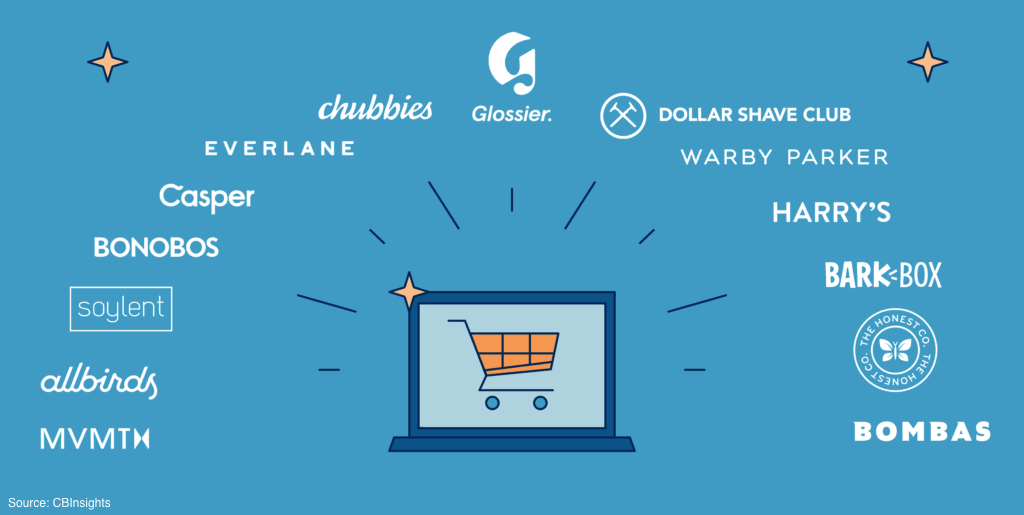Brands aren’t built overnight. Some of the most successful brands (Nike, LVMH, etc) have taken years to achieve the awareness (and more importantly relevance) they have now. In the case of LVMH, there is a key element to owning a piece of European heritage that has driven the company to be the largest luxury goods company in the world. Louis Vuitton owns much of their own supply chain. As an example, over the past couple of years they opened a manufacturing center in Texas to create leather goods here in the US that further allows them to create local stories around their products.
Compare this with the majority of DNVB’s (digitally native vertical brands) that sell on the internet today. The majority of these are not vertically integrated (save for Harry’s and a few others) and are taking advantage of the commoditization of tools/resources which make it much easier to scale a business (driven by Shopify, Braintree, contract manufacturers, 4PL’s, etc). While this has created a lot of new brands, its has also led to the paradox of choice among shoppers and low barriers to entry for competitors. The vast majority of physical products in your home are under attack by an insurgent startup brand offering better value propositions, sadly I don’t believe there is enough differentiation to justify the valuations investors have pegged on some of these companies.
Many of these DNVB’s have been propped up by venture capital investors who essentially are subsidizing marketing at the expense of true R&D, to create growth. Marketing costs have ballooned for DTC brands because more competition has led to race to the bottom on biddable media. My belief is the majority of VC dollars should be spent on true NRE/R&D as is the case with software companies or on businesses that have defensible IP or truly unique business models that offer attributes like recurring revenue. Look at the playbook from the incumbents over the last 50 years. They recognized that durable categories weren’t as profitable as consumables. So what did they do? They blended the two together (think Razor/razorblade). Today, durable DTC brands are discovering the same thing. If you’re in a business with a long sales cycle (think furniture and appliances) LTV is difficult to calculate and you lack the ability to create recurring revenue. Entrepreneurs should consider revenue based financing programs to fund marketing CAC and not dilute themselves by giving away precious equity for marketing spend; reserve dilution for things that will add deep moats to a business. DNVB’s are not tech businesses. The same way Netflix is not a tech company, as Benedict Evans from a16z proclaims.
The upward bias continues as long as these brands are able to raise money to subsidize marketing but margins matter more than ever now (think WeWork, Uber, SmileDirect) and it will be difficult for DNVB to hit the public markets unless they’re profitable. I believe we’ll see a continued pullback in investment among this cohort. We’ve already seen Softbank backed Brandless shuttered and on the M&A front, there are two omnipresent headwinds: first, the days of paying 6x+ revenue to acquire an upstart have evaporated. Many are still holding onto the Dollar Shave Club/Blue Buffalo headlines when Unilever and General Mills respectively paid large sums of money to acquire them. Strategic buyers simply aren’t often willing to shell out that kind of money to allow the VC’s to hit their returns. Furthermore, profitability matters and acquirers have watched tepid reactions to DTC brands that hit the public markets with disappointing fundamentals. Secondly, there’s an issue of regulatory concern. In 2020, Edgewell called off their proposed acquisition of Harry’s due to potential antitrust issues and similarly, P&G abandoned their planned acquisition of Billie in January of this year. All this is to say that VC investments in DNVB will likely cool which is a great opportunity for the RBI firms (see post here on that).
All said, I’m a firm believer that the incumbents in CPG, etc need to be challenged and believe DNVB’s are the answer. Success here lies in building a more defensible position through unique IP and creating a fully vertically integrated supply chain with less reliance on contract manufacturers.

